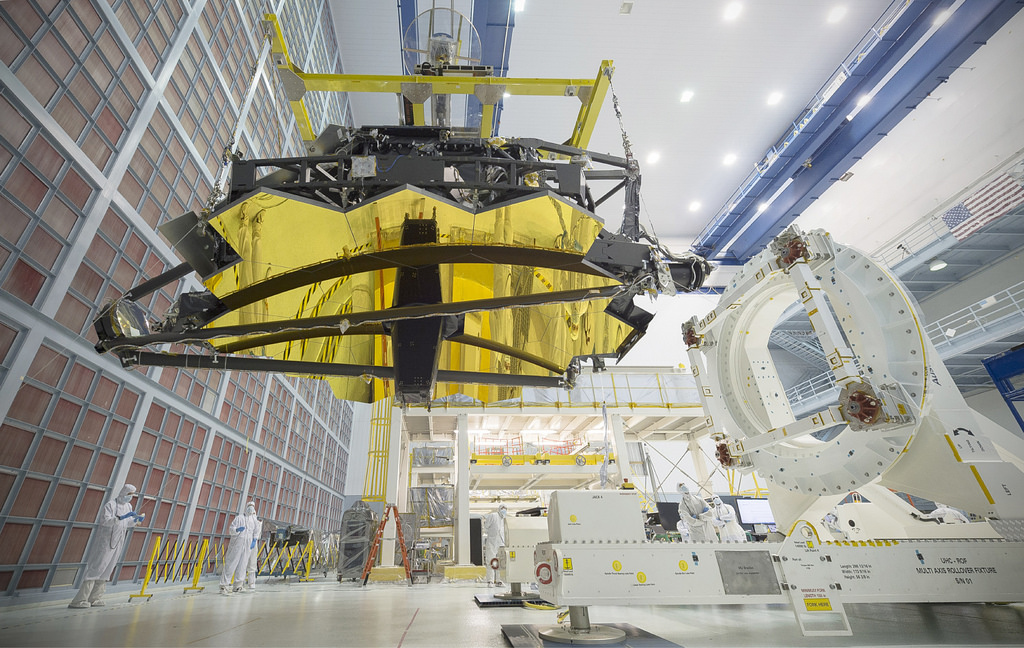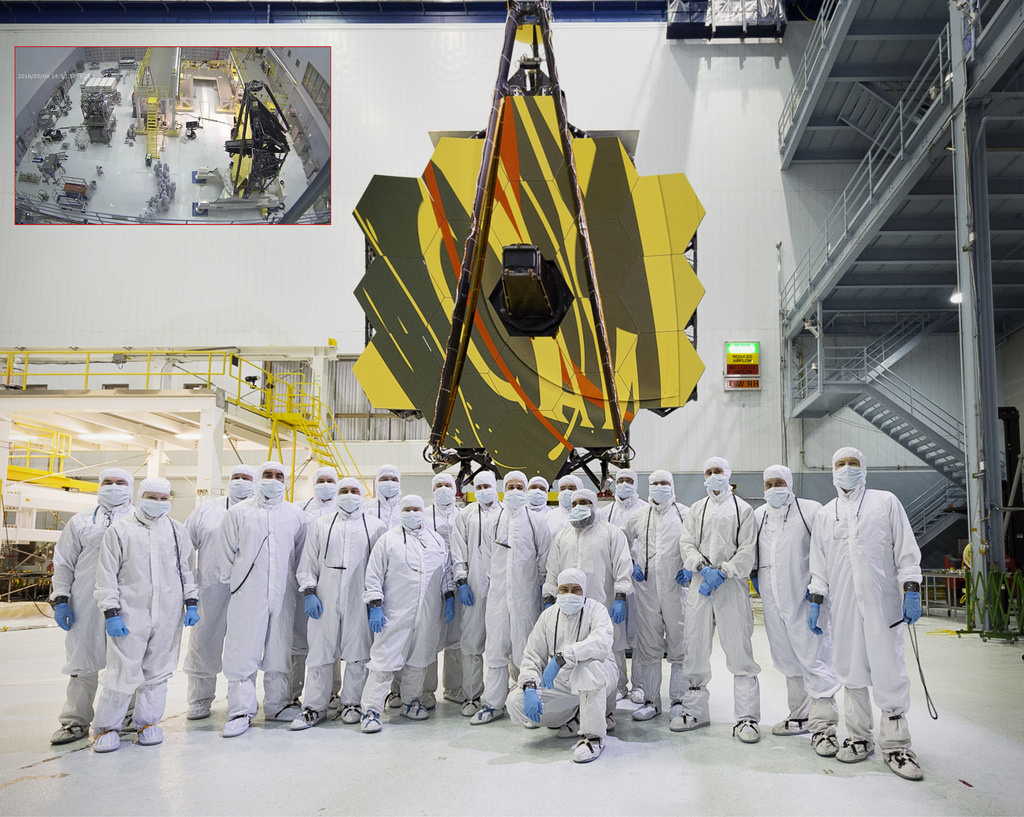
A team of over 1000 people from 17
countries is currently working on the James Webb Space Telescope. Three space
agencies are collaborating on this major undertaking, including NASA (National
Aeronautics and Space Administration in the United States), CSA (Canadian Space
Agency), and ESA (European Space Agency). Many believe this will be the next
great space telescope of our time and they have high hopes that the James Webb
will further elucidate the conditions of the early universe because of its
ability to detect ancient radiation released from events in the distant past.
countries is currently working on the James Webb Space Telescope. Three space
agencies are collaborating on this major undertaking, including NASA (National
Aeronautics and Space Administration in the United States), CSA (Canadian Space
Agency), and ESA (European Space Agency). Many believe this will be the next
great space telescope of our time and they have high hopes that the James Webb
will further elucidate the conditions of the early universe because of its
ability to detect ancient radiation released from events in the distant past.
Previously, the Hubble Space Telescope has
been (and still is) the main work-horse of planetary discovery and space
imaging. Launched over 26 years ago in 1990, Hubble has served well despite initial
problems with its mirror (which were later corrected by astronauts who worked
on Hubble while in orbit). The new James Webb telescope will benefit from the
hard-learned lessons of Hubble and will incorporate current technology which
surpasses that installed on Hubble. The ground glass mirror on Hubble is 2.4
metres in diameter, while the compound 6.5 metre diameter mirror of the James
Webb is a gold-coated beryllium reflector. The collecting area of the Hubble is
4.5 m2 while the James Webb will have a collecting area of 25 m2.
Hubble has four main instruments on board, while James Webb will have five
high-tech devices for viewing a wide spectra of radiation including UV,
Infra-Red, and visible light.
been (and still is) the main work-horse of planetary discovery and space
imaging. Launched over 26 years ago in 1990, Hubble has served well despite initial
problems with its mirror (which were later corrected by astronauts who worked
on Hubble while in orbit). The new James Webb telescope will benefit from the
hard-learned lessons of Hubble and will incorporate current technology which
surpasses that installed on Hubble. The ground glass mirror on Hubble is 2.4
metres in diameter, while the compound 6.5 metre diameter mirror of the James
Webb is a gold-coated beryllium reflector. The collecting area of the Hubble is
4.5 m2 while the James Webb will have a collecting area of 25 m2.
Hubble has four main instruments on board, while James Webb will have five
high-tech devices for viewing a wide spectra of radiation including UV,
Infra-Red, and visible light.
Of further note is the difference in orbit
of the two telescopes. While Hubble travels in a low-earth, geocentric orbit,
the James Webb Space Telescope will be situated near Lagrange 2 relative to the
Sun and Earth. This means that it will be in a reasonably stable orbit with an
equal gravitational tug from both Earth and the Sun. This will put the James
Webb much further from the Earth and other radiometric influences and will
allow it to peer deep into space away from the Sun and Earth.
of the two telescopes. While Hubble travels in a low-earth, geocentric orbit,
the James Webb Space Telescope will be situated near Lagrange 2 relative to the
Sun and Earth. This means that it will be in a reasonably stable orbit with an
equal gravitational tug from both Earth and the Sun. This will put the James
Webb much further from the Earth and other radiometric influences and will
allow it to peer deep into space away from the Sun and Earth.
The launch is scheduled for October 2018
and researchers anticipate five to ten years of functionality. The launch mass
is sizable (6,500 kg) and the 18 facets of the mirror must be folded for launch
and deployed in space. There is much that could go wrong in such a complex
system and so we pray for a safe and efficient launch of the James Webb Space
Telescope.
and researchers anticipate five to ten years of functionality. The launch mass
is sizable (6,500 kg) and the 18 facets of the mirror must be folded for launch
and deployed in space. There is much that could go wrong in such a complex
system and so we pray for a safe and efficient launch of the James Webb Space
Telescope.
Details:
James Webb – 25 m2 collecting
area; five main instruments: NIRCam – Near IR Camera, NIRSpec – Near-Infrared
Spectrograph, MIRI – Mid IR Instrument, NIRISS – Near Infrared Imager and
Slitless Spectrograph, FGS – Fine Guidance Sensor; 6.5-meter-diameter
gold-coated beryllium reflector with a collecting area of 25 m2
area; five main instruments: NIRCam – Near IR Camera, NIRSpec – Near-Infrared
Spectrograph, MIRI – Mid IR Instrument, NIRISS – Near Infrared Imager and
Slitless Spectrograph, FGS – Fine Guidance Sensor; 6.5-meter-diameter
gold-coated beryllium reflector with a collecting area of 25 m2
Hubble: 2.4 metre mirror; 4.5 m2
collecting area; four main instruments observe in the near ultraviolet,
visible, and near infrared spectra; When finally launched in 1990, Hubble’s
main mirror was found to have been ground incorrectly, compromising the
telescope’s capabilities. The optics were corrected to their intended quality
by a servicing mission in 1993.
collecting area; four main instruments observe in the near ultraviolet,
visible, and near infrared spectra; When finally launched in 1990, Hubble’s
main mirror was found to have been ground incorrectly, compromising the
telescope’s capabilities. The optics were corrected to their intended quality
by a servicing mission in 1993.
Sources
Cited:
Cited:
NASA.gov, NASA Website, “James Webb Space
Telescope,” http://jwst.nasa.gov/public.html,
viewed 2016-07-22.
Telescope,” http://jwst.nasa.gov/public.html,
viewed 2016-07-22.
Wikipedia, “James Webb Space Telescope,” https://en.wikipedia.org/wiki/James_Webb_Space_Telescope,
viewed 2016-07-22.
viewed 2016-07-22.
Wikipedia,
“Lagrangian Point,” https://en.wikipedia.org/wiki/Lagrangian_point,
viewed 2016-07-22.
“Lagrangian Point,” https://en.wikipedia.org/wiki/Lagrangian_point,
viewed 2016-07-22.
